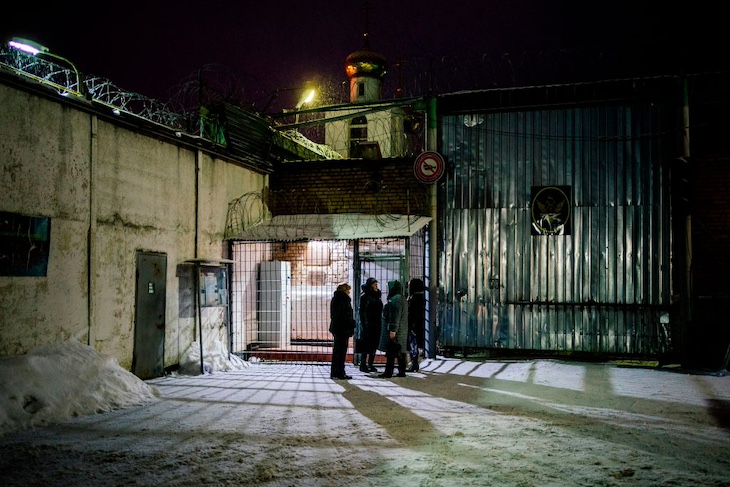On Friday, a hostage crisis unfolded at the IK-19 prison colony near Volgograd, the southern Russian city once known as Stalingrad. Four convicts – who declared themselves members of Islamic State – took 12 of their wardens and fellow inmates captive. In one video a guard can be seen lying in a pool of blood, his throat slit. Three more hostages lost their lives before special forces stormed the penitentiary and neutralised their captors with extreme prejudice.
Friday’s incident follows an earlier hostage-taking by Isis two months ago at a detention centre in Rostov, where all six jailhouse jihadis were gunned down by police. These events pose the question: what’s happening in Russia’s prisons?
In the past, Russian prisons were divided into ‘red’ and ‘black’ zones: red penitentiaries were governed by the authorities, black ones were ruled by ‘thieves’ law’ – the vory v zakone, a distinctive underworld subculture of tattooed mobsters with an elaborate convict hierarchy. This subculture was born in Stalin’s gulags. It turned a life of crime into an ideal: a true vor (thief) cast aside all the trappings of mainstream society – a job, a family – and lived exclusively by stealing or gambling.
To be ‘crowned’ a vor was like being a ‘made man’ in the mafia: you must have someone vouch for you and prove yourself worthy before being admitted to the inner circle. This gave you a level of authority over your fellow inmates. Beneath you were blatniye, who respected the thieves’ code but were not yet vory themselves; muzhiki, everyday lags just serving their time; kozli (goats) who collaborated with the guards; and finally petukhi (roosters), forced to clean the latrines. Nonces were roosters by default. There’s echoes of the Indian caste system, in that the roosters cannot even be touched lest you lower yourself to their level.
This began changing in the turbulent decade following the fall of communism, when gang warfare raged in the streets as everyone tried to get a slice of the fresh capitalist pie. Meanwhile, an actual war was raging in the south as Chechen rebels fought to free themselves from Moscow’s grip, and drugs flooded in from Central Asia. Devastated by a civil war which left tens of thousands dead, the impoverished nation of Tajikistan became a major gateway for Afghan heroin and hashish, which to a lesser extent flowed through Kazakhstan, Kyrgyzstan and Uzbekistan as well as directly from Afghanistan itself. The Central Asian diaspora in Russia largely consists of migrant workers in thankless, poorly-paid jobs, routinely enduring harassment from the police and everyday citizens.
This influx of Chechen prisoners of war and Central Asian drug dealers shifted Russia’s prison demographics. The Muslims rejected the caste system imposed by the blacks – all were equal in the eyes of Allah.
‘In our colony, the camp was divided in two,’ Chechen journalist Zhalaudi Geriyev, who was framed and imprisoned by tyrannical officials, told me.
‘We had the Jamaat, i.e. Muslims, who are united on the basis of religion; and then there was the “black mass”, which in Russian prisons are the thieves’ faction. To avoid conflicts and maintain order the two groups agreed that those who want to live by religious principles can live one way, and those who want to live by the thieves’ rules can live another.’
The Muslims are considered neither red nor black, but green, a colour strongly associated with Islam.
From the mid-2000s to the early 2010s Russia suffered a surge of neo-Nazi violence as skinhead gangs beat, shot and stabbed foreigners and minorities, seemingly at random. The ringleaders were rounded up and locked away, where they also tried to form their own faction, the whites, much like the Aryan Brotherhood in America, but they simply lacked the manpower to wield any serious influence.
Inside prison, the jihadi radicalisation pipeline is well-documented. By its very nature, prison isn’t a place that fosters healthy psychological development. Prisoners are often angry at the system for locking them away to rot and they need somewhere to channel that rage. Both gangsterism and terrorism are adept at attracting these angry and lost individuals. Each comes with a sense of brotherhood, identity and excitement, and a chance to prove yourself by vanquishing foes. Religion also offers redemption from a lowlife lifestyle.
Jihadism benefits too from the logistics of the criminal underworld. Terrorists need cash, guns and the ability to slip across borders, all things that the underworld can readily provide. Therefore, it’s not surprising Isis has actively recruited ex-cons. ‘Sometimes people with the worst pasts create the best futures,’ read one Isis propaganda poster beneath a picture of a man wielding a Kalashnikov.
It’s no coincidence that Amedy Coulibaly and the Kouachi brothers, the gunmen who carried out the Charlie Hebdo massacre, all served time on drugs charges. Deso Dogg, the Berlin rapper turned Isis jihadi, ran with the 36 Boys gang and was arrested numerous times for violating the German Opium Act. According to the Belgian Federal Prosecutor, half of his country’s jihadists which left to fight in Syria had criminal records.
It seems to be the same in Russia. Indeed, three of Friday’s institutionalised insurgents were convicted drug traffickers, while the fourth was serving time for killing a man during a fistfight. All four men were of Central Asian origin – marginalised, alienated and exploited in Russian society, a prized demographic for Isis recruiters.







Comments